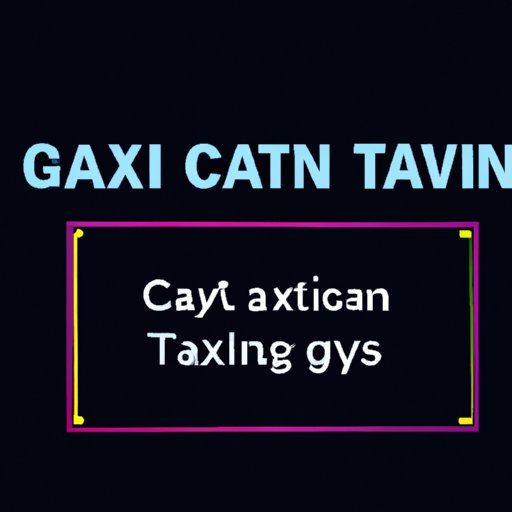Introduction
Capital gains tax is a tax levied on profits made from the sale of certain types of assets, such as stocks, bonds, real estate, and other investments. It’s an important concept to understand if you’re making investments or trading in any of these asset classes, as the amount of taxes you owe can have a significant impact on your overall returns. In this article, we’ll explore capital gains tax in detail, covering everything from what it is and how it works, to strategies for minimizing your taxable liabilities.

Explaining Capital Gains Tax: A Comprehensive Guide
Before we dive into the nitty-gritty of capital gains tax, let’s take a look at the basics. To start, let’s answer some of the most common questions about capital gains tax.
What is Capital Gains Tax?
Capital gains tax is a tax imposed on the profits from the sale of certain types of assets. When you sell an asset for more than you paid for it, that profit is considered a capital gain. The amount of capital gains tax you owe depends on the type of asset sold, the length of time you owned it, and your tax filing status. Most countries have some form of capital gains tax, though the exact rules and regulations vary by jurisdiction.
How Does It Work?
When you sell an asset that has increased in value since you purchased it, the resulting profit is subject to capital gains tax. The amount of tax you owe depends on the type of asset sold, the length of time you held it, and your tax filing status. For example, long-term capital gains are generally taxed at a lower rate than short-term capital gains.
Should You Pay Capital Gains Tax?
Whether or not you need to pay capital gains tax depends on a variety of factors, including the type of asset sold, the length of time you held it, and your tax filing status. Generally speaking, you should pay capital gains tax when you sell an asset that has increased in value since you purchased it. However, there are certain exceptions, such as the exclusion of certain types of capital gains from taxation, or the ability to defer capital gains taxes through certain investment vehicles.
Who Pays Capital Gains Tax?
Generally speaking, anyone who sells an asset for more than they paid for it is subject to capital gains tax. This includes individuals, corporations, partnerships, trusts, and estates. The amount of tax owed depends on the type of asset sold, the length of time it was held, and the taxpayer’s tax filing status.
A Step-by-Step Guide to Understanding Capital Gains Tax
Now that we’ve covered the basics, let’s look at the step-by-step process of understanding capital gains tax. Here are the key steps you need to take to ensure you’re calculating your capital gains correctly and paying the right amount of tax.
Calculating Your Capital Gains
The first step in understanding capital gains tax is to calculate your capital gains. To do this, you’ll need to subtract the cost basis (the amount you paid for the asset) from the proceeds (the amount you received when you sold the asset). The difference between the two amounts is your capital gain (or loss).
Reporting Capital Gains on Taxes
Once you’ve calculated your capital gains, you’ll need to report them on your taxes. You’ll need to include the total amount of capital gains you earned during the year on your tax return, along with any applicable deductions or credits. You may also be required to report capital gains on other forms, such as the Schedule D form for investors.
Filing Taxes with Capital Gains
Once you’ve reported your capital gains on your tax return, you’ll need to determine how much capital gains tax you owe. This amount will depend on the type of asset sold, the length of time you held it, and your tax filing status. You’ll then need to pay the appropriate amount of tax before filing your return.

Capital Gains Tax Basics: What You Need to Know
In addition to the basics of capital gains tax outlined above, there are a few other key concepts you need to understand. Here are the basics of capital gains tax you should know.
Types of Capital Gains Tax
There are two main types of capital gains tax: short-term and long-term. Short-term capital gains are gains from assets held for one year or less, while long-term capital gains are gains from assets held for more than one year. The tax rate for short-term capital gains is generally higher than the rate for long-term capital gains.
Short-term vs. Long-term Capital Gains
The length of time you hold an asset affects the amount of tax you owe on any capital gains you earn from it. Generally speaking, the longer you hold an asset, the lower your tax rate will be. Short-term capital gains are taxed at ordinary income tax rates, while long-term capital gains are taxed at a lower rate.
Capital Losses and the Wash Sale Rule
In addition to capital gains, you can also incur capital losses when you sell an asset for less than you paid for it. These losses can be used to offset your capital gains, reducing the amount of tax you owe. However, there are certain restrictions on capital losses, such as the wash sale rule, which limits your ability to use losses to offset gains.
Capital Gains Tax Strategies for Beginners
If you’re just getting started with investing and trading, there are a few strategies you can use to minimize your capital gains tax liability. Here are a few tips to get you started.
Tax Deferral Strategies
One of the best ways to reduce your capital gains tax liability is to use tax deferral strategies. These strategies allow you to postpone the payment of taxes on your capital gains until a later date. Examples of tax deferral strategies include investing in tax-deferred retirement accounts and using tax-deferred exchange programs.
Investing in Tax-advantaged Accounts
Investing in tax-advantaged accounts can also help reduce your capital gains tax liability. Tax-advantaged accounts, such as 401(k)s and IRAs, offer special tax benefits that can help you save money on taxes. For example, contributions to a 401(k) are tax-deductible, and earnings are not subject to taxes until withdrawal.
Utilizing Tax Loss Harvesting
Tax loss harvesting is another strategy you can use to reduce your capital gains tax liability. This strategy involves selling investments that have lost value in order to offset any capital gains you’ve earned. This allows you to reduce the amount of taxes you owe on your capital gains.
How to Calculate Capital Gains Tax in the United States
Now that you’re familiar with the basics of capital gains tax, let’s look at the specifics of calculating your capital gains tax in the United States. Here’s how to do it.
Computing Your Taxable Capital Gains
The first step in calculating your capital gains tax is to compute your taxable capital gains. To do this, you’ll need to subtract the cost basis (the amount you paid for the asset) from the proceeds (the amount you received when you sold the asset). The difference between the two amounts is your taxable capital gain (or loss).
Calculating Your Tax Liability
Once you’ve computed your taxable capital gains, you’ll need to calculate your tax liability. This amount will depend on the type of asset sold, the length of time you held it, and your tax filing status. You’ll then need to pay the appropriate amount of tax before filing your return.

Investing and Capital Gains Tax: What You Should Know
Finally, if you’re planning on investing or trading, there are a few things you should know about capital gains tax. Here’s what you need to know.
Tax Implications of Trading
When you trade stocks, bonds, or other investments, you may incur capital gains or losses. If you make a profit, you’ll need to pay taxes on your capital gains. On the other hand, if you incur a loss, you may be able to use it to offset your capital gains and reduce the amount of taxes you owe.
Capital Gains Tax Rates
The amount of capital gains tax you owe will depend on the type of asset sold, the length of time you held it, and your tax filing status. Generally speaking, long-term capital gains are taxed at a lower rate than short-term capital gains. Additionally, certain types of capital gains may be excluded from taxation altogether.
Tax Benefits of Investing
In addition to minimizing your capital gains tax liability, there are several other tax benefits of investing. For example, you may be able to deduct certain expenses related to your investments, such as transaction fees and investment advisory fees. Additionally, you may be able to take advantage of tax-advantaged accounts, such as 401(k)s and IRAs.
Conclusion
Capital gains tax is an important concept to understand if you’re investing or trading in any of the asset classes subject to capital gains tax. This article has provided a comprehensive overview of capital gains tax, from what it is and how it works, to strategies for minimizing your tax liability. With this knowledge, you’ll be better equipped to make informed decisions about your investments and trading activities.
(Note: Is this article not meeting your expectations? Do you have knowledge or insights to share? Unlock new opportunities and expand your reach by joining our authors team. Click Registration to join us and share your expertise with our readers.)
